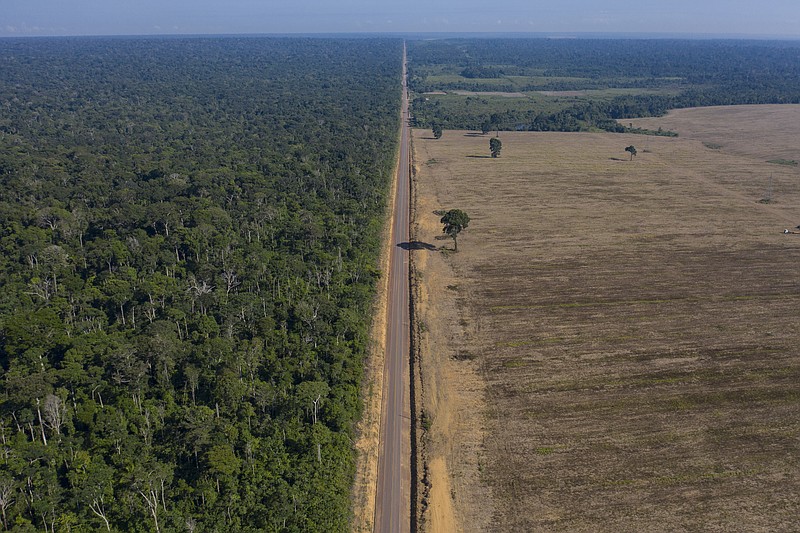TRAIRAO, Brazil (AP) — Night falls in Brazil’s Amazon and two logging trucks without license plates emerge from the jungle. They rumble over dirt roads that lead away from a national forest, carrying trunks of trees hundreds of years old.
After pulling onto a darkened highway, the truckers chug to their turnoff into the woods, where they deliver their ancient cargo. By morning, the trunks are laid out for hewing at the remote sawmill, its corrugated metal roof hardly visible from the highway.
The highway known as BR-163 stretches from soybean fields to a riverside export terminal. The loggers were just south of the road’s juncture with BR-230, known as the Trans-Amazon. Together the highways cover more than 5,000 miles, crossing the world’s fifth-biggest country in the state of Para.
Carved through jungle during Brazil’s military dictatorship in the 1970s, the roads were built to bend nature to man’s will in the vast hinterland. Four decades later, there’s development taking shape, but also worsening deforestation — and locals harbor concerns that progress may pass them by.
COLONIZATION DREAM
The highways first meet in the city of Ruropolis, where the military government promised land to lure people to the planned agricultural village. One 53-year-old man, Hilquias Soares, remembers a state agent in his hometown yelling, “Who wants to go to Para?”
His family took the chance, arriving just after President Emílio Médici, a general, inaugurated the town. Archival footage shows Médici unveiling a plaque reading: “The Brazilian people respond to the challenge of history, occupying the heart of the Amazon.” Children play on see-saws and show off T-shirts with the crossroads sprawling across the continent-sized nation.
“There was a dream of colonization, of getting land and seeing if here we could have better financial conditions,” Dedé Diniz, 69, said in his home. “A lot of people don’t recognize what we did, what we fought for.”
Diniz examines a photograph he took of Médici and, below it in his album, a shot of a truck trapped in mud. It’s nothing like the bucolic painting on his wall that shows farm furrows and wild forest beside the highway, where a machine repairs ruts.
He joked he’ll update the painting with asphalt soon — that stretch should be paved by 2021. Already people have started moving in from other states to buy land for cattle pastures.
ROAD WARRIORS
From Ruropolis, the Trans-Amazon and BR-163 run jointly westward over a bumpy 70 miles before splitting at a little roundabout. During corn and soy harvests, 2,600 trucks pass through each day to and from the nearby Tapajos River.
There, trucks pull into transshipment ports. Grain cascades from their containers to be loaded onto barges. After a downriver trip that takes days, the grain is poured into ships’ holds and dispatched across the world, largely to China.
That transoceanic network seems far removed from the road warriors filling up on grilled beef or bowls of açai in truck stops. While the truckers eat, grease-stained mechanics replace worn-out shocks and blown-out tires.
At the start of Bolsonaro’s administration, only 32 miles of BR-163 from soy country to the Trans-Amazon remained to be paved. However, tropical rains transformed the dirt into impassable mud. Soy trucker Sandro Vieira recalled being stuck in gridlock two years ago, consuming nothing but bread, coffee and peanuts for a week; to this day, the smell of peanuts disgusts him.
Bolsonaro’s government last month finished paving the soy corridor. The decades-delayed achievement is the first of major public works to come, Infrastructure Minister Tarcísio de Freitas said. They include a $3 billion grain railway alongside BR-163.
A ministry promotional video for foreign investors shows deer and other wild animals in their habitats, living in harmony with highways.
“We know Brazil has a responsibility to the world, and we will fulfill our responsibility,” de Freitas said.
IMPROVED ACCESS
The two highways opened up the rainforest — and viewed from above, the landscape is slashed by jagged stitches of cleared forest on both sides.
Roads themselves aren’t the problem today, said Paulo Barreto, a forest engineer and researcher at environmental group Imazon.
The issue, he said, is that improved access has been accompanied by Bolsonaro’s rhetoric emboldening illegal loggers while his administration undermines its own environmental regulator.
“If those things continue, deforestation will explode in the area,” Barreto said.
Official data show Amazon deforestation rose almost 30 percent in the 12 months through July, to its worst level in 11 years. Para state alone accounted for 40 percent of the loss, with a heat map of incidents running along the Trans-Amazon and BR-163. The Jamanxim national forest, alongside BR-163, had the second most deforestation of any protected area.
Paulo Bezerra, a leader of the Munduruku indigenous people who live around the highways, said in an interview that farmers from Mato Grosso and other states are using tractors to rip down trees near his village, and try to intimidate tribesmen into silence. They said they’re afraid of being killed.
After the global spotlight turned to Brazil in August as the Amazon burned, Bolsonaro dismissed the huge fires as normal practice for clearing pasture and farmland.

